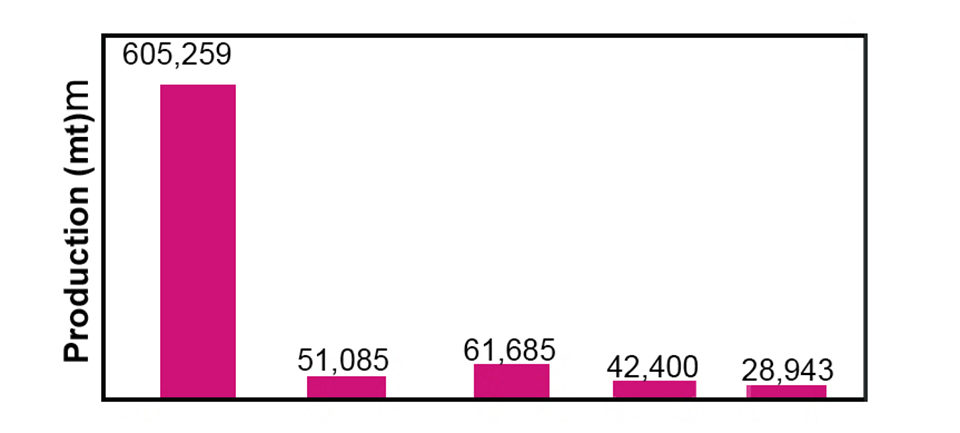Species quickly becomes one of China’s most important

Pacific white shrimp (Litopenaeus vannamei) were experimentally introduced in China in 1988, and the reproductive cycle was closed in hatcheries after 1992. In 1998, a specific pathogen-free stock was introduced from Hawaii, and spawners and postlarvae have been introduced on a commercial scale since then. Nowadays, over 1,000 hatcheries supply L. vannamei postlarvae to shrimp farmers in China, most of which are located in the provinces of Guangdong and Hainan in the southern part of the country.
Strong production
In 2003, China’s hatcheries produced over 241 billion shrimp postlarvae – 112,622 billion L. vannamei and 128,653 billion other species. The yield of L. vannamei from sea water farm ponds was 308,947 metric tons (MT), which accounted for 63 percent of the total marine shrimp-farming production, while 296,312 MT were reported from fresh water ponds (Figs. 1 and 2). With an estimated total value of U.S. $1 billion, L. vannamei has quickly become one of the most important aquaculture species in China in terms of production scale and economic value.


L. vannamei adapt well to higher stocking densities during culture, relative to other farmed shrimp species. In southern China, two crops can normally be harvested per year, and production in well-managed ponds usually ranges 7.5-15 metric ton per hectare per crop. In the provinces of Shandong, Hebei, and Liaoning in northern China, where water temperatures allow only about 100 days of culture annually, one good crop of L. vannamei can be achieved.
Greenhouses or small-scale ponds covered with plastic film are used to headstart the culture cycle of L. vannamei in the early spring or later autumn in the northern pro-vinces, to ensure a stable supply of fresh live shrimp for markets. In protected, well-managed farming facilities, L. vannamei biomass can reach 5 kilogram per square meter per crop and higher (Fig. 3).

Impacts

After the 1993 collapse of the shrimp-farming industry caused by white spot syndrome virus, the positive impacts of the L. vannamei introduction to China are evident. The introduction provided a new species for the industry, and new ideas such as biosecurity and healthier production practices were introduced, along with the development and implementation of new farming models and techniques.
There have also been some negative impacts, including known and new pathogens introduced along with the shrimp. Also, the use of underground water to culture L. vannamei in inland areas might have environmental impacts. Finally, the potential impacts of L. vannamei escapes to the local ecosystem should be evaluated in the long term.
(Editor’s Note: This article was originally published in the October 2005 print edition of the Global Aquaculture Advocate.)
Now that you've finished reading the article ...
… we hope you’ll consider supporting our mission to document the evolution of the global aquaculture industry and share our vast network of contributors’ expansive knowledge every week.
By becoming a Global Seafood Alliance member, you’re ensuring that all of the pre-competitive work we do through member benefits, resources and events can continue. Individual membership costs just $50 a year. GSA individual and corporate members receive complimentary access to a series of GOAL virtual events beginning in April. Join now.
Not a GSA member? Join us.
Authors
-
Dr. Wang Qing-Yin
Yellow Sea Fisheries Research Institute
Chinese Academy of Fishery Sciences
106 Nanjing Road, Qingdao 266071
P.R. China -
Dr. Li Jian
Yellow Sea Fisheries Research Institute
Chinese Academy of Fishery Sciences
106 Nanjing Road, Qingdao 266071
P. R. China -
Dr. Yang Cong-Hai
Yellow Sea Fisheries Research Institute
Chinese Academy of Fishery Sciences
106 Nanjing Road, Qingdao 266071
P. R. China
Tagged With
Related Posts

Health & Welfare
Alphavirus replicon particles potential method for WSSV vaccination of white shrimp
A study demonstrated that VP19 and VP28 white spot syndrome virus envelope proteins expressed by replicon particles provided protection against mortality due to WSSV in shrimp.

Health & Welfare
Ammonia addition enhances microbial flocs in nursery phase for Pacific white shrimp
In a study, “pre-fertilization” in the nursery phase of a biofloc system for shrimp was tested. The objective was to accelerate the biofloc formation to minimize ammonia concentrations, avoiding high peaks during culture.

Health & Welfare
A study of Zoea-2 Syndrome in hatcheries in India, part 1
Indian shrimp hatcheries have experienced larval mortality in the zoea-2 stage, with molt deterioration and resulting in heavy mortality. Authors investigated the problem holistically.

Health & Welfare
Culture of Pacific white shrimp juveniles in super-intensive conditions
Results of this study showed that L. vannamei juveniles can be cultured at high densities with adequate survival, growth and feeding efficiency, and with minimal water exchange or full water reuse through recirculation.


